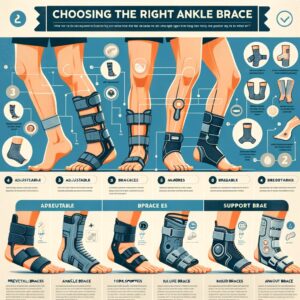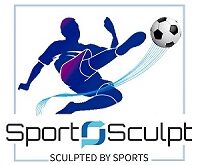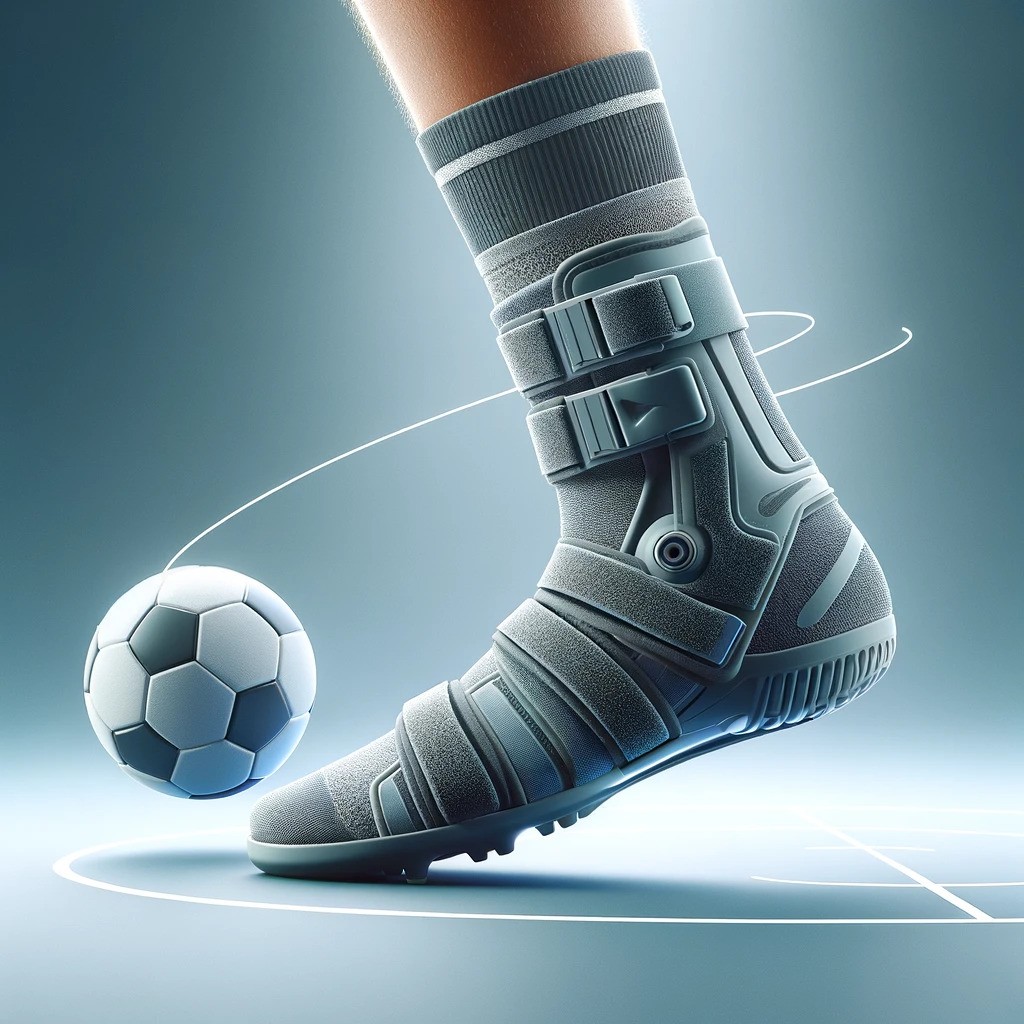Soccer is not just a game; it’s a passion that drives young athletes to push their limits on the field. However, with high intensity comes the risk of injury, particularly to areas as vulnerable as the ankles. In the dynamic world of youth soccer, an ankle brace emerges not merely as a protective gear but as a crucial companion for young athletes. It stands as a testament to the blend of care, support, and performance enhancement that every young player needs.
Understanding Ankle Braces
Ankle braces are engineered marvels designed to encompass the ankle, offering a blend of support, protection, and injury prevention. They serve as a guardian for the ankle, working tirelessly to absorb shocks, distribute pressure evenly, and stabilize the joint during rapid, multi-directional movements typical in soccer. By doing so, they minimize the risk of ankle sprains and injuries, which are common in sports involving swift changes in direction, jumps, and landings.
The science behind ankle braces is rooted in their ability to restrict excessive movement that can lead to injury while allowing for the necessary mobility needed in soccer. They achieve this through various means, such as compression, which increases proprioception (the body’s ability to sense its position in space), and physical support structures that prevent unnatural ankle movements.
Types of Ankle Braces
When it comes to protecting young athletes on the soccer field, choosing the right type of ankle brace is crucial. Ankle braces come in various forms, each designed to meet different needs and preferences. Understanding the differences can help in selecting the most appropriate option for a young soccer player.
Lace-Up Ankle Braces
Lace-up ankle braces are reminiscent of a tightly laced boot, offering a customizable fit that ensures the ankle is snugly supported. Their structure is designed to mimic the support system of a well-fitted shoe, providing both lateral (side-to-side) and medial (inward) support. This type of brace is particularly favored for its ability to adjust the tightness, allowing for a personalized level of support that can be modified as the player’s needs change.
Hinged Ankle Braces
Hinged ankle braces are the hybrid vehicles of ankle support; they offer the flexibility needed for forward movement and the rigid support necessary to prevent lateral instability. These braces typically feature hinges that allow for natural up-and-down motion, making them ideal for athletes who are returning to play after an injury and need protection against movements that could re-injure the ankle.
Compression Ankle Sleeves
Compression ankle sleeves are the lightweight, agile members of the ankle brace family. Made from stretchable materials, they slip on over the ankle, providing mild compression that helps reduce swelling and improve blood flow. While they may not offer the robust support of lace-up or hinged braces, they are perfect for athletes looking for a preventive measure that doesn’t impede their natural movement or comfort.
Benefits of Ankle Braces in Soccer
Ankle braces are not just about injury prevention; they bring a myriad of benefits to young soccer players, enhancing their overall playing experience.
- Injury Prevention: The most evident benefit of ankle braces is their role in reducing the risk of ankle injuries. By providing stability and support to the ankle joint, braces help prevent the excessive movements that can lead to sprains and fractures. This is particularly important in soccer, where quick directional changes, jumps, and impacts are frequent.
- Support and Stability: Beyond preventing injuries, ankle braces offer a sense of support and stability that can boost a player’s confidence on the field. Knowing their ankles are well-protected allows players to focus on their game and perform to their best ability, without the fear of injury holding them back.
- Enhanced Performance: While the primary function of ankle braces is protective, they can also contribute to improved performance. By stabilizing the ankle joint, braces can enhance proprioception – the sense of body position and movement – which is crucial for maintaining balance, executing precise footwork, and delivering powerful shots. The psychological benefit of feeling secure and supported can also not be underestimated, as it encourages players to push their limits with greater confidence.
Choosing the Right Ankle Brace

Selecting the right ankle brace is a decision that should be tailored to the individual needs of the young soccer player. Here are key factors to consider:
- Size and Fit: It’s imperative to choose an ankle brace that fits well. A brace that’s too tight may restrict blood flow and movement, while one that’s too loose won’t provide adequate support. Many brands offer size charts based on shoe size or ankle circumference, which can be a helpful guide in finding the right fit.
- Material and Comfort: Since the brace will be worn during rigorous activity, selecting a breathable, moisture-wicking material is essential to keep the ankle cool and dry. Comfort is also crucial, as any irritation or discomfort can distract the player and impact their performance.
- Level of Support: The choice between a lace-up brace, hinged brace, or compression sleeve should be influenced by the level of support the player needs. Factors such as the history of ankle injuries, personal preference for flexibility vs. stability, and any specific recommendations from a healthcare professional should be considered.
Making an informed choice about ankle braces can significantly impact a young soccer player’s ability to perform at their best while minimizing the risk of injury. With the right support around the ankle, players can focus on developing their skills, enjoying the game, and achieving their full potential on the soccer field.
Top Recommended Ankle Braces for Youth Soccer Players
Here are some of the top recommended ankle braces for youth soccer players, categorized based on their purpose:
For Injury Prevention:
- McDavid Ankle Brace: This is a versatile brace available in both lace-up and sleeve styles. It’s made from breathable materials for comfort and offers good overall support for weak ankles or those prone to sprains.
- Bauerfeind MalleoTrain: This brace utilizes a unique knit design to provide targeted compression and moderate support, helping prevent injuries during regular play.
For Recovery:
- DonJoy Performance Trizone Ankle Support: This sleeve brace offers mild to moderate support and features built-in silicone banding for targeted compression. It’s lightweight, breathable, and comfortable for extended wear during recovery from sprains or strains.
- Aircast ASO Ankle Stabilizer: This semi-rigid brace provides more support than sleeve braces and helps limit ankle movement. It’s suitable for recovering from moderate ankle sprains or other injuries.
Additional factors to consider:
- Size: Ensure the brace fits snugly but comfortably without restricting movement.
- Ease of use: Choose a brace your child can easily put on and take off independently.
- Durability: Opt for a brace built to withstand the demands of soccer activities.
Remember, consulting a doctor or physiotherapist is crucial before choosing an ankle brace, especially for recovery purposes. They can assess your child’s specific needs and recommend the most suitable option.
Conclusion
Incorporating ankle braces into the gear of a young soccer player offers a blend of injury prevention, enhanced performance, and peace of mind for both the player and their guardians. By choosing the right type of brace, maintaining it properly, and making informed decisions based on quality and professional advice, players can significantly reduce their risk of ankle injuries.
This careful approach allows young athletes to fully engage in the sport they love, focusing on developing their skills and enjoying the game with the confidence that they are protected against common injuries. Remember, the goal is to support the youth in their soccer journey, ensuring they have the tools and knowledge to play safely and perform at their best.
Frequently Asked Questions
Can you play soccer with an ankle brace on?
Yes, you can play soccer with an ankle brace on. Ankle braces are designed to be worn during physical activities, including soccer, to provide support and protection to the ankle joint. They are made to fit comfortably under soccer socks and shoes, allowing players to perform without significant restriction.
Should youth athletes wear ankle braces?
Youth athletes, especially those playing high-impact sports like soccer, can benefit from wearing ankle braces. Ankle braces offer support, reduce the risk of ankle injuries, and provide stability during quick movements, making them a wise choice for young players aiming to stay safe on the field.
What is the best ankle brace for soccer players?
The best ankle brace for soccer players often depends on individual needs, such as the level of support required and any previous ankle injuries. Generally, lace-up ankle braces and hinged ankle braces are highly recommended for their adjustable support and ability to balance flexibility with stability, making them suitable for active soccer players.
Is it better to tape or brace your ankles for soccer?
Both taping and bracing have their advantages for soccer players. Taping offers a customizable fit but requires time and skill to apply correctly. Ankle braces provide convenient, reusable support and can be more cost-effective over time. The choice between taping or bracing often comes down to personal preference, comfort, and specific protection needs.
What do soccer players use to protect their ankles?
Soccer players use a variety of gear to protect their ankles, including ankle braces, compression sleeves, and athletic tape. Ankle braces are a popular choice for their ease of use, adjustable support, and effectiveness in preventing injuries during play.
What are the disadvantages of ankle braces?
While ankle braces offer many benefits, there are some disadvantages to consider. They can restrict movement if too tight or not fitted properly, potentially altering natural playing techniques. Over-reliance on braces may also lead to decreased muscle strength around the ankle if not used as part of a balanced training and rehabilitation program. It’s important to use them judiciously and in conjunction with proper training to avoid these potential downsides.

